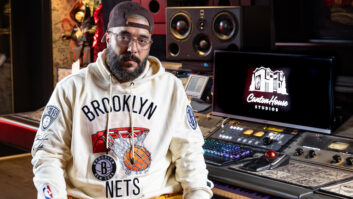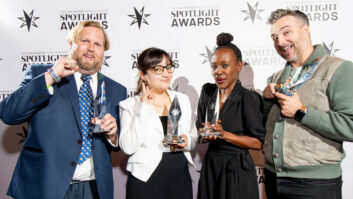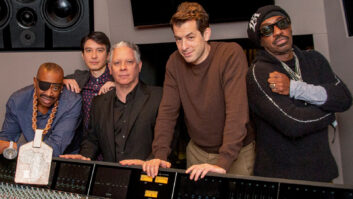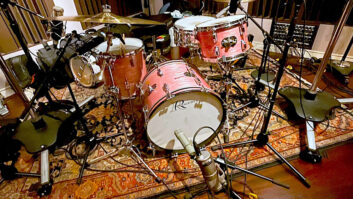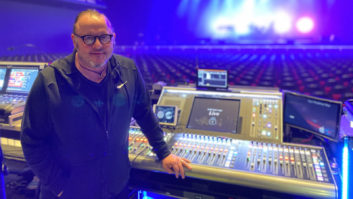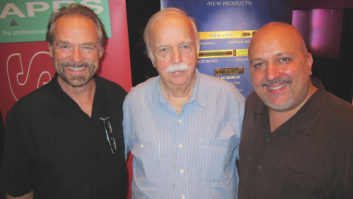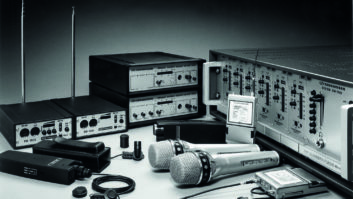
ON THE COVER: INNER MACHINE
Inner Machine (Buffalo, N.Y.) is enjoying a second life thanks to a couple of former studio gofers, Robby Tacak and John Rzeznik — now better known as Goo Goo Dolls. Twenty years ago, Tacak and Rzeznik were working for then-owner Alan Baumgardner and his commercial clients. They recently purchased the studio, and with the help of the original designer, John Storyk and wife/partner Beth Walters, founders of Walters-Storyk Design Group, they’ve made the rooms over to support their own projects.
“I first designed this studio, then called Trackmasters, over 30 years ago,” Storyk says. “Obviously, it needed to be renovated. The equipment was tired, they needed a new mechanical room — but the main acoustic need for Johnny [Rzeznik] was to completely change the acoustic signature of the live room, creating an enhanced reverb time, capable of recording drums and other session work, specifically for the group.”

Photo: Bob Musell
WSDG added a vocal booth and spec’d new surface treatments in all of the rooms. “The curved soffits on the [tracking room] ceiling were refilled and resurfaced,” he explains. “We changed all of the original fabric to wood membranes with specific finishes. There are two different wood thicknesses to give a variety of membrane absorption characteristics at low frequencies. We introduced a variable-acoustic panel system on the walls, due to the need to deaden the room from time to time. The default RT60 for the room is close to 1.0 seconds and smooth through the entire frequency domain.“
The owners worked with WSDG system engineer Judy Brown to integrate an API Legacy console, new main monitors and a large collection of vintage outboard gear. A full-range Augspurger monitor system will soon be installed under the guidance of Professional Audio Design. The control room photo shows that two racks (far right) are detached from the rest; these racks on rollers house Rzeznik’s favorite pieces of gear (Groove Tubes Vipre mic pre’s and Glory Comp compressors; Mercury EQ-P1s, M76ms and M72s; RCA BA 6A; Chandler Limited TG2 and others) and can be moved all the way forward to the mix position.
“I’m proud of the fact that this room that we built 30 years ago, whose infrastructure is still sound, could be reborn to accept totally different acoustic requirements,” Storyk says. “Often when a studio’s purpose ends, the studio dies, but this studio is now rebuilt to serve a new purpose that’s consistent with what artists and bands are doing in the 21st century.”

Photo: George Roos
2 HARD RECORDS
Francis Manzella (FM Design Ltd.) designed this recording studio for Jeremy Harding’s 2 Hard Records label in Kingston, Jamaica. Harding, who manages Platinum artist Sean Paul, works with other local producers and writers, and produces 2 Hard artists in his new studio, which opened in December 2007. Equipment includes Digidesign D-Command and Pro Tools HD, Griffin G1.5 main monitors and loads of MIDI gear.

Photo: Juergen Nogai
JNH STUDIOS
Studio A of composer James Newton Howard’s personal facility in Santa Monica, Calif., includes architectural and technological updates to the room that studio bau:ton originally designed for him in 1996. The redesign, by bau:ton’s Peter Grueneisen, opened the space to accommodate a large flat-panel monitor on the front wall. An equipment rack was removed and bass trapping was reconfigured to accommodate a new seating area on a riser behind the composer’s desk. The sloping front wood ceiling was also replaced with a high, nearly level fabric surface, and warm cherry flooring and paneling were added. Howard’s extensive equipment includes a Euphonix System 5 console and B&W monitoring. The redesign was completed in January ’08.

Photo: Jordan Tarlow
RADIOBU
Russ Berger Design Group designed this 1,100-square-foot studio, which serves as the new home of Sirius Satellite program Martha Quinn Presents. Located in Malibu, Calif., the studio is also available for theatrical, television and Web 2.0 post-production, audio mixing and voice-over projects. Design features include custom acoustic fabric wall and ceiling treatments, walnut flooring and lots of natural light. Open for business in February ’08, the studio has a 32-channel Digidesign ICON system with 48-channel analog I/O, API and tube front end, SSL summing, a selection of vintage mics and outboard, ISDN and custom Precision Kinetics 7.1 surround monitoring.

Photo: Neil Waving
CREAM
Cream Recording Studios is a new music recording/mixing facility housed within the London headquarters of UK-based equipment supplier/rental company GearBox. Opened in March ’08, Cream was designed by Roger D’Arcy of Recording Architecture to accommodate large-scale music production, with an emphasis on film scoring and other sound-for-picture projects. Cream features a new 72-channel SSL Duality analog console, custom ATC surround monitoring, and a wide choice of vintage and classic mics, and outboard gear.

Photo: L.P. Swist
CALIFORNIA ROAD STUDIOS
Situated in Orchard Park, N.Y., is California Road Studios, a multipurpose tracking/mixing facility by Lawrence P. Swist Designs. The studio opened in September ’07, and features an 800-square-foot tracking room and a 120-square-foot iso booth. Designer Larry Swist reports that the large room has a 1.6-second reverb time optimized for drum tracking; reverb times can also be adjusted down to accommodate a variety of production requirements. Featured equipment includes Pro Tools HD3, a Digidesign D-Command console, Avalon and Focusrite mic pre’s, and Dynaudio 5.1 monitoring.

Photo: George Roos
KMA MUSIC
In the heart of Manhattan, KMA Music was designed by Francis Manzella (FM Design Ltd.) as a mixing, tracking and writing studio for independent engineers and producers, as well as for KMA’s staff composers. Situated in the Brill Building, KMA opened in April 2007 and offers a Digidesign ICON, Pro Tools HD, Griffin G1.5 main monitors, a Yamaha Grand and an unsurpassed view of Times Square.

Photo: Tom Arban
HUMBER RECORDING STUDIOS
This studio opened in September ’07 to serve the music and recording programs at Toronto’s Humber Polytechnic College. Designed by Canadian firm The Delarson Group, Humber Recording has a 30×30-foot main tracking room with variable acoustics, as well as two iso booths and a 30×20-foot control room with RPG Quadratic Diffusors. Major equipment includes an SSL Duality 48, Pro Tools HD2 and Dynaudio surround monitoring.

Photo: Precision Acoustic Design
AARON MERRILL MUSIC & SOUND
Composer/producer/engineer Aaron Merrill completed his new facility in Highland, Utah, in March ’08. The hybrid studio was designed by Precision Acoustic Design to accommodate a variety of audio, music and film-scoring tasks. The 23×21-foot control room features a custom 10-foot touch-screen control surface, and the 20×18-foot recording area has 12 adjustable acoustic panels that let in natural light and allow control over the room’s characteristics and reverb time.

Photo: Dennis O’Reilly
FRASER PERFORMING AND RECORDING STUDIO
Dennis Janson (Janson Design Group) designed this studio for WGBH Boston Public TV and Radio (Brighton, Mass.). Pictured is the tracking room of this 2,000-square-foot space with a 28-foot ceiling. Acoustical features include double-wall construction around the studio on spring-isolated, floating concrete floors. RPG Quadratic Diffusors are installed on the lower-half of the walls, with 2-inch-thick, fabric-wrapped panels fixed to the upper-half. Ceiling panels are RPG Skyline 3-D diffusors, and corner bass traps are built in. The studio opened in September ’07, and features an SSL C224 mixer, ATC mains and Aviom Pro 16-channel headphone mix/monitoring to supplement a proprietary headphone/cue system.

Photo: Benny Chan/Fotoworks
JCB MUSIC
With a design by Studio 440 Architecture & Acoustics, the main control room of JCB Music (Santa Monica, Calif.) is configured for composing and recording. RPG acoustical treatments are strategically placed to enhance acoustics and reverb time. Isolated and/or floating cement slabs were used to isolate spaces, and room-within-a-room construction helps ensure low background-noise levels. JCB is equipped with a Euphonix System 5 console, Genelec 1039A LCR mains, and Yamaha O1V and O2R96 mixers. The studio opened in June ’07.

Photo: Steve Cridland
SETAI RECORDING STUDIO
Situated in the penthouse of the Setai Hotel (South Beach, Fla.), artist Lenny Kravitz’s Setai Recording overlooks the Atlantic. Kravitz and his team envisioned the studio as a warm and luxurious facility that would provide the same level of service that is offered by the hotel. Matt Knobel led the technical design; acoustical design was by Ross Alexander (Synergetic Services), and includes custom-fabricated modules for LF control, mid- and high-frequency diffusion, and critically located mid/high absorption. Miami’s Acoustical Components provided additional wall and ceiling finishes. The studio went online in January with an SSL C200 console and ATC monitors.

Photo: Tim Gaudreau
WESLEYAN EXPERIMENTAL MUSIC STUDIO
Completed in September ’07, the Experimental Music Studio at Wesleyan University (Middletown, Conn.) serves as a recording/mixing space for student music and post-production projects. Lou Clark of Sonic-Space designed the studio to be acoustically neutral and flexible. Equipment from MOTU, Alesis, Tascam, Mackie and more is on rolling equipment racks, and the room has large gobos with built-in diffusers that create a large, cylindrical diffuser when they are placed next to each other. Rigging bars mounted to the ceiling, down the center and around the perimeter of the room allow speakers to be hung in a variety of positions.

Photo: Jomar Braganca
DIANTE DO TRONO
The most striking element of Diante Do Trono (Belo Horizonte, Brazil) is probably the way in which three of the main Genelec 1032 5.1 surround speakers are housed within the panoramic glass wall between the tracking and control rooms. Other equipment includes a Digidesign Control|24 console, Pro Tools HD3, and a selection of outboard processing and vintage mics. The Walters-Storyk Design Group designed the facility, which opened in February ’08 and includes a 600-square-foot live room and a 350-square-foot control room with two iso booths.

Photo: Reese Boisse
METHODS AND APPLICATION LABORATORY
In the Northeast corner of Mercenary Audio’s Foxboro, Mass., warehouse is the new Methods and Applications Laboratory (MethLab). The studio was designed by Fletcher and the Mercenary Design Group/CNF Consulting to handle sessions and serve as a research facility for developing and testing new equipment designs. Though much of the gear changes with new consulting projects, the room is centered around a modified 32×8 Yamaha PM2000 and custom monitors controlled by a Crane Song Avocet. Acoustics are based on a modified live-end/dead-end design; murals, animal-print fabrics and carpet complete the aesthetic.

WATCH:
More Studio Openings!
